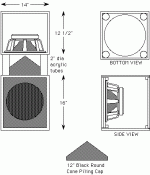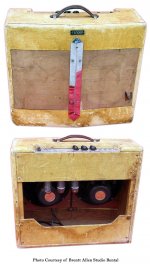(((• Omnidirectional guitar speaker project •)))
(((•)))
Using Your favorite guitar speaker, Celestion or whatever, facing down because facing up would become a dust collector, and reflection angle would be better if unit is about 36” high.
For amp I plan to use one of the new pedal amps like the Quilter InterBlock 45, so no traditional amp head to deal with. Or if your favorite amp is a Marshall or Fender or whatever head, a stand could be constructed that also serves as a guitar stand and junk box.
Experimental build coming soon.....
(((•)))
Using Your favorite guitar speaker, Celestion or whatever, facing down because facing up would become a dust collector, and reflection angle would be better if unit is about 36” high.
For amp I plan to use one of the new pedal amps like the Quilter InterBlock 45, so no traditional amp head to deal with. Or if your favorite amp is a Marshall or Fender or whatever head, a stand could be constructed that also serves as a guitar stand and junk box.
Experimental build coming soon.....
Attachments
Isn't it strange that the instrument that was once too quiet to hear in a band (acoustic guitar) morphed into the most obnoxiously loud instrument in the room / club / stadium?
It seems that too-loud acoustic drumsets (evolved by armies from much less-loud folk drums), and too-loud electric guitars (evolved from too-quiet acoustic guitars), have forced tens of thousands of musicians to play too loud, and eventually damage their hearing.
-Gnobuddy
Guitar amps beam for a reason. Guitarists like there guitars loud. And like any musician, if you cant hear yourself you cant play properly. So most guitarists like there amps close. As a bass player, keep your guitar amps beaming and point them at your head. There almost always too loud for me otherwise.
in the wrong acoustic environment an omni type cab would be horrid....as a soundman i always encourage guitar players to point their amps at the bass player 😀
Totally true, in a soundman situation. However ..... for a different listening experience, in a small club or in my basement, I want something, especially for synth output, that is not directional. So I can have guitar sound through my Super Reverb, and synth sound through the onni speakers.
I would not want it all the time just as I wouldn’t want meat loaf everyday for dinner. Think of it as a special effect like the old Leslie speakers.
I would not want it all the time just as I wouldn’t want meat loaf everyday for dinner. Think of it as a special effect like the old Leslie speakers.
as an effect ok but not all the time please...where's me scotch...
meatloaf...when's his next album?
oh oh ..."sign of the gypsy queen" leslie effect on guitar,right?
meatloaf...when's his next album?
oh oh ..."sign of the gypsy queen" leslie effect on guitar,right?
Last edited:
Well, if we're being serious, they beam because they use a single large speaker to cover the entire electric guitar frequency range, from roughly 80 Hz to roughly 5 kHz.Guitar amps beam for a reason.
For a twelve-inch speaker, (lambda/pi) equals the speaker diameter at roughly 360 Hz. Beaming is already significant by that frequency, and only gets worse as the frequency goes higher. By 5 kHz the wavelength is fourteen times smaller, and the speaker beams like a searchlight.
Some do - high SPL is almost intoxicating for some people.Guitarists like there guitars loud.
The rest of us - me for one - don't like high SPL, but there are two things that force its use: one, if you're playing with a drummer, modern rock drums are ridiculously loud, and nobody will hear the guitar if it's not also ridiculously loud. Two, until very recently, the best sounding guitar amps were always valve amps, and they tended to only sound good once they were cranked up to ridiculous loudness levels.
Both these are just technological artifacts. Traditional drums have existed for thousands of years all over the world, and very few are deafeningly loud. But then armies took to using a drummer to keep the soldiers marching in time. This forced the drum to evolve from its traditional origins and become very loud, so that long columns of soldiers could still hear the drums at the back of the line.
Rock drums - the kind used in modern popular music, which is a pretty recent phenomenon as history goes - started out as military drums, and then evolved to be even louder, as they had to fill big dance halls in an era long before sound reinforcement systems existed.
Now the big dance bands are long-dead, and so are huge venues for rock music without a sound reinforcement system. So we no longer need ludicrously loud drums. But, though various attempts towards less-loud drums have been made, most remain far too loud. Tens of thousands of parents, music teachers, and wannabe-drummer kids would be grateful for less-loud acoustic drums; but they really don't exist.
The story with valve guitar amps is similar. They got loud to be heard over the loud drums, in an era when the guitar did not go through the P.A. system, even in large venues. Decades later, manufacturers were still churning out 40-watt valve guitar amplifiers connected to speakers with a sensitivity of 100 dB@1 watt @ 1 metre, meaning these amps were capable of 116 dB at the guitarists ears. Worse, those amps only sound good once pushed to nearly their limit, particularly for rock, so there was no practical way to reduce the loudness to a safe level.
As with drums, there have been a handful of attempts to produce good sound at reasonable SPL from a valve guitar amp, but the industry at large focussed on more SPL, not less.
For example, there are the family of Two Notes Torpedo devices (some costing up to $750 US). Add your $1500 Fender valve guitar amp, and another $1000 for a pair of flat-frequency-response monitor speakers, and you can finally have good valve guitar amp sound at living-room volumes. At a mere $3250 USD or so. 😱
If you search online electronics forums (including this one), there were always tons of posts from people trying to build quieter valve guitar amps, either by using oddball lower-power tubes, or by building speaker attenuators of some sort. So it's obvious that there was a sizeable segment of the guitar-amp market that was not being served by the guitar amp manufacturing industry.
After many years of trying to get good valve guitar amp tone at living-room-friendly SPLs, I gave up and bought a solid-state Boss Katana 50. With no output valves that need to be driven into nonlinearity to sound good, it can be turned down surprisingly low, and still sound good.
Too loud for the guitarist as well, as evidenced by the hordes of deaf or nearly-deaf guitarists who used to play very loudly until they damaged their hearing severely.As a bass player, keep your guitar amps beaming and point them at your head. The(y')re almost always too loud for me otherwise.
If COVID-19 continues to keep us shut in our homes for years, I wonder if the drum and guitar amp industry will finally start to evolve quieter products. They are badly needed, particularly now that tens of thousands of musicians are forced to practice in their apartments.
-Gnobuddy
FOLLOW Physics Laws instead of fighting them 🙂
People who KNOW their Physics:
SUNN

Behringer/Bugera


CARVIN

People who KNOW their Physics:
SUNN

Behringer/Bugera


CARVIN

Attachments
I knew there had once been a V-front Fender, but I couldn't remember what model. I thought it was a Harvard, but that was wrong. And Google was no help without the exact model name. 🙂PRR said:...Fender V-front super...
-Gnobuddy
Now, that one I had never heard about. Thanks!JMFahey said:Gibson GA79RVT
So the idea did catch on with at least a few guitar amp manufacturers - but very briefly, apparently ending after Watkins, Fender, and Gibson each made a single model.
I'm not surprised Leonidas cost-engineered his way to a flat baffle. I'm a little more surprised Gibson didn't continue with the idea.
Perhaps customers didn't want the unusual appearance?
Of course, two angled speakers don't actually solve the dispersion problem. You have two searchlight-beams of treble instead of one; an improvement, but not the same thing as uniform dispersion over a reasonably wide "sweet spot".
Speaker cab emulation and flat-response speaker systems using actual tweeters do solve the problem - but, for now, good systems like this are very expensive, and the affordable ones are not very good.
-Gnobuddy
That's an interesting thought. Instead of actually spinning the speaker(s) like a Leslie, just add a motor to wobble the single guitar speaker a bit. 😀
-Gnobuddy
-Gnobuddy
- Home
- Live Sound
- Instruments and Amps
- dispersion on the guitar cab





